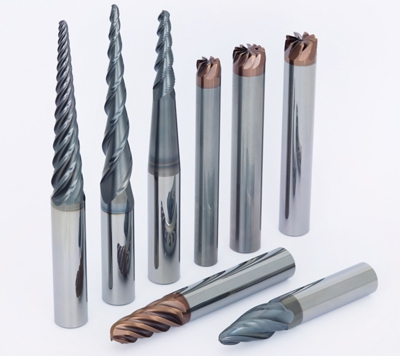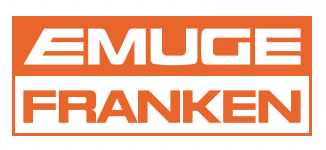
Emuge Corp. introduced a new solid-carbide Turbine end mills program for milling turbine blades, impellers, blisks and other complex 5-Axis components. Emuge Turbine end mills feature a variety of styles including tapered ball nose, unique barrel-shape designs and optimum tool selections from their Top-Cut, Tinox-Cut, Multi-Cut and Indexable Insert Tooling programs.
"We are very pleased to offer our customers excellent solutions for milling turbines blades," said Charles Colonair, Milling Product Manager at Emuge Corp. "OEMs and job shops in industries such as automotive, aerospace and power generation will benefit from increased productivity using these tools."
The Emuge Turbine End Mill line includes Barrel-Shaped Oval Form End Mills, which provide manufacturers with an exceptionally efficient finishing tool for high-strength materials. The unique barrel-shaped oval form simulates the attributes of ball nose end mills having a diameter range of 150-190mm, to provide double the axial cut vs. a standard ball nose end mill, for a fine surface finish. The Barrel-Shaped Oval Form End Mills are offered with 3 and 4 flutes with ALCR (aluminum-chromium) coating and have a form tolerance of +/- 0.01mm (0.0004"), providing highly accurate low-vibration machining.
Torus End Mills for the semi-finishing and finishing of turbine blades feature 5 – 13 flutes with variable spacing to minimize vibrations while machining. Designs include corner radius (0.8mm, 1mm and 2mm), straight and 8° taper angle versions. Internal coolant supply capability is provided. Tapered Ball Nose End Mills are offered with a 4° taper angle and feature a design with 3 flutes in the ball nose section and 6 flutes radially, a design which provides tool stability and improved surface finish of turbine blades. Torus and Tapered Ball Nose End Mills are especially well suited for milling in high-strength materials such as nickel-based alloys and titanium alloys. Both styles of end mills feature advanced multilayered TiALN coating for high heat resistance.
Emuge also offers Tapered Ball Nose End Mills in the new program that excel in the roughing, semi-finishing and finishing of impellers. These Tapered Ball Nose end mills have a 3 flute design with a 4° taper angle and also feature a design with 3 flutes in the ball nose section and 6 flutes radially. ALCR coating allows for these tools to achieve higher feed speeds, metal removal rate and extremely high performance especially in difficult-to-cut materials.
Contact Details
Related Glossary Terms
- alloys
alloys
Substances having metallic properties and being composed of two or more chemical elements of which at least one is a metal.
- coolant
coolant
Fluid that reduces temperature buildup at the tool/workpiece interface during machining. Normally takes the form of a liquid such as soluble or chemical mixtures (semisynthetic, synthetic) but can be pressurized air or other gas. Because of water’s ability to absorb great quantities of heat, it is widely used as a coolant and vehicle for various cutting compounds, with the water-to-compound ratio varying with the machining task. See cutting fluid; semisynthetic cutting fluid; soluble-oil cutting fluid; synthetic cutting fluid.
- feed
feed
Rate of change of position of the tool as a whole, relative to the workpiece while cutting.
- finishing tool
finishing tool
Tool, belt, wheel or other cutting implement that completes the final, precision machining step/cut on a workpiece. Often takes the form of a grinding, honing, lapping or polishing tool. See roughing cutter.
- flutes
flutes
Grooves and spaces in the body of a tool that permit chip removal from, and cutting-fluid application to, the point of cut.
- gang cutting ( milling)
gang cutting ( milling)
Machining with several cutters mounted on a single arbor, generally for simultaneous cutting.
- indexable insert
indexable insert
Replaceable tool that clamps into a tool body, drill, mill or other cutter body designed to accommodate inserts. Most inserts are made of cemented carbide. Often they are coated with a hard material. Other insert materials are ceramic, cermet, polycrystalline cubic boron nitride and polycrystalline diamond. The insert is used until dull, then indexed, or turned, to expose a fresh cutting edge. When the entire insert is dull, it is usually discarded. Some inserts can be resharpened.
- milling
milling
Machining operation in which metal or other material is removed by applying power to a rotating cutter. In vertical milling, the cutting tool is mounted vertically on the spindle. In horizontal milling, the cutting tool is mounted horizontally, either directly on the spindle or on an arbor. Horizontal milling is further broken down into conventional milling, where the cutter rotates opposite the direction of feed, or “up” into the workpiece; and climb milling, where the cutter rotates in the direction of feed, or “down” into the workpiece. Milling operations include plane or surface milling, endmilling, facemilling, angle milling, form milling and profiling.
- milling machine ( mill)
milling machine ( mill)
Runs endmills and arbor-mounted milling cutters. Features include a head with a spindle that drives the cutters; a column, knee and table that provide motion in the three Cartesian axes; and a base that supports the components and houses the cutting-fluid pump and reservoir. The work is mounted on the table and fed into the rotating cutter or endmill to accomplish the milling steps; vertical milling machines also feed endmills into the work by means of a spindle-mounted quill. Models range from small manual machines to big bed-type and duplex mills. All take one of three basic forms: vertical, horizontal or convertible horizontal/vertical. Vertical machines may be knee-type (the table is mounted on a knee that can be elevated) or bed-type (the table is securely supported and only moves horizontally). In general, horizontal machines are bigger and more powerful, while vertical machines are lighter but more versatile and easier to set up and operate.
- titanium aluminum nitride ( TiAlN)
titanium aluminum nitride ( TiAlN)
Often used as a tool coating. AlTiN indicates the aluminum content is greater than the titanium. See coated tools.
- tolerance
tolerance
Minimum and maximum amount a workpiece dimension is allowed to vary from a set standard and still be acceptable.

